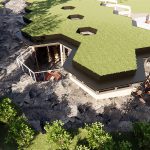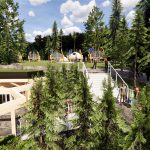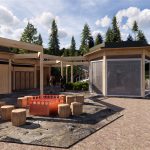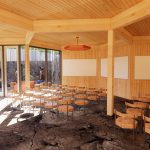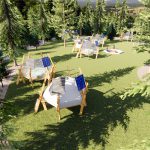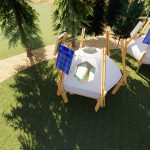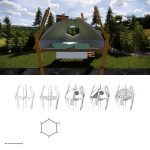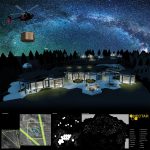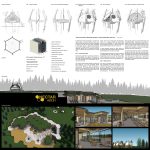Nectar
Project Name
Nectar
“the honeycomb is absolutely perfect in economizing labor and wax.”
-Charles Darwin
To minimize the effort of building in a remote area, a structural system based on smaller components that could be carried or dragged on skids to the site and then easily assembled to form larger spaces was utilized. Separating the sleeping huts from the lodge allowed for a small village of residential spaces and a contrasting communal space – smaller groups combining to form a larger tribe.
Lodge
By choosing a site with a rock outcrop, the lodge is able to be nestled into a hillside. The planted sod roof allows for partial replacement of the disturbed area.
The canopy, with its biophilic design, is constructed with maximum 11’-0” long composite lumber beams, it is bolted together and provides the primary shelter in the compound. Some of the cells are left open to provide soft shading.
Panels, built of CLT, Honeycomb poly-carbonate, screen, or an insulated textile are de-mountable and can be moved to create different spaces in the lodge as well as control the degree that the lodge is open to weather.
A ramp extends around the back allows for accessible access and creates a series of interstitial spaces between the rock face and the lodge.
The toilet, shower and kitchen rooms are constructed of prefabricated CLT walls and ceilings. These components would be built off site and brought into the wilderness by helicopter. The kitchen pod features a public front and rear preparation zone.
Huts
The Huts are situated on the upper part of the site, looking over the planted roof canopy to the view beyond. Each hut is self-sufficient. The structure is laminated wood, secured to a helical pile foundation system. It is easily disassembled and the piles removed with minimal site disturbance. The enclosure of each hut is 6 textile panels, based on spacesuit technology, that are zipped together. The panels are a sandwich of ballistic nylon, mylar honeycomb insulation, and an inner layer that has radiant tubes woven into it for heating in colder months. In warmer weather, entire panels can be unzipped and replaced with screen mesh panels.
The huts feature solar hot water and photovoltaic panels mounted to the structure to provide power for lighting, a circulation pump and device charging. The heated water is stored in a slim cylinder buried under each hut and a battery back is suspended under the platform to store power. Huts can be assembled low to the ground to provide accessibility or on stilts.
Furniture and Site Accessories
All of the furniture was designed or selected to mimic the hexagonal structure of the project. The chairs and stools are intended to be hewn and shaped roughly into hexagonal shapes and assembled with legs and supports on site. Commercially manufactured furniture is brought to the site flat-pack intended to be assembled in situ.
Measure 1: Design for Integration
The entire wilderness lodge and sleep hut complex is designed to be easily established on site and to have a minimal impact. No structural member is longer than 12’ and can be carried in on a skid. Each hut can be assembled as parts of a kit and easily assembled.
Measure 2: Design for Community
On a wilderness trail, the community takes on a different meaning. This project is designed to foster community and interaction between hikers, scientists and other experts. The experience of being in the lodge is instantly the feeling of belonging to the ever-changing community. Most of the occupants are hikers or visitors who share a love of nature and gentle exploration.
Measure 6: Design for Energy
The sleeping huts are for living off grid all year long. They are simple timber structures, easily erected and feature a dynamic skin inspired by spacesuits. The skin – a layered composition of nylon taffeta canvas, a closed loop radiant tube warming/cooling system with a cistern below the hut, mylar honeycomb insulating skin, recycled denim batt insulation a gore-tex breathable layer and an exterior of ballistic nylon is attached to the frame with tension cables and panels are secured with large industrial zippers. The solar hot water panel produces hot water for the heating system. The photovoltaic panel collects energy that is stored in a battery mounted below the hut to provide all day power for lighting and charging of mobile devices.

